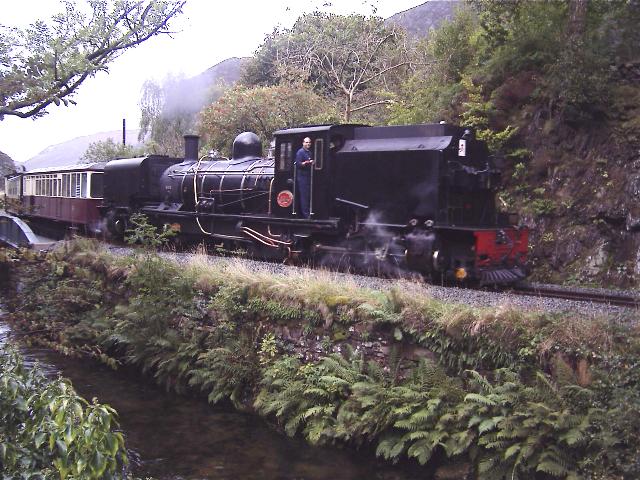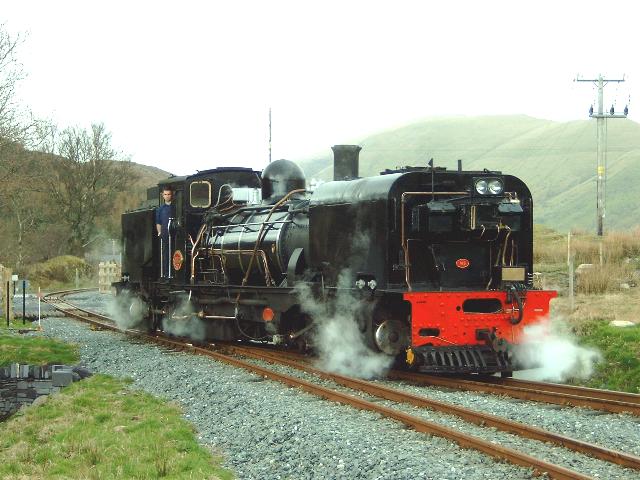|
|
NGG16 No.129 Puffing Billy Railway |
|

NGG16 No.129
steaming into Gembrook Station, Puffing Billy Railway on a rainy summer day, 7
January 2024.
This pleasing view
was kindly contributed by Thomas Mullens.
|
Builder |
Manchester
UK |
|
||||||||||||||||||||||||||||||||||||||||||||||||||||||||||||||||||
|
Builder’s
Number & Year |
7430
of 1951 |
|
||||||||||||||||||||||||||||||||||||||||||||||||||||||||||||||||||
|
Wheel
Arrangement |
2-6-2
+ 2-6-2 |
|
||||||||||||||||||||||||||||||||||||||||||||||||||||||||||||||||||
|
No.
in class |
34 |
|
||||||||||||||||||||||||||||||||||||||||||||||||||||||||||||||||||
|
South
African Railways narrow gauge & the NGG16 class: The South African Railways operated a number of 2’ gauge
railways that were somewhat analogous to the Victorian Railway’s narrow-gauge
(2’ 6”) routes as they were built as developmental lines, often in difficult
country, as a way of opening up areas while avoiding the higher construction
costs of the ‘Cape Gauge’ (3’ 6”). Some of the South African narrow-gauge
lines were later converted to Cape Gauge, while others eventually closed due
to falling traffic and road competition. Notable among the 2’ gauge lines was
the Alfred County Railway, a private operation which took control of the Port
Shepstone to Harding narrow-gauge branch line from the South African Railways
and remained in operation for freight until 2001 and passenger operation
until 2005. The Alfred County Railway ran a fleet NGG16 Beyer-Garratts and
even rebuilt two examples (No.141 & No.155) with various ‘gas producer’
boiler, firebox and exhaust modifications to improve efficiency. An interesting selection of tender and tank locomotives
from various international builders were used on the South African Railways
2’ gauge lines. Beyer-Garratt articulated locomotives proved very successful
with the South African Railways and accordingly the type was also applied to
their narrow-gauge routes, starting with the NGG11-class of 2-6-0 + 0-6-2
ordered in 1914 (but delivered in 1919 as a result of World War 1 delays).
The final development was the NGG16 type, 34 examples of which were
constructed by various builders. Incredibly, the last batch NGG16 locomotives
were constructed as late as 1968. A treasured book in the webmaster’s library is ‘Railways
of Southern Africa 150 Years’ by Jean A. Dulez; this weighty tome is a
fabulous reference of information and photographs covering the many public
and private railways and locomotives that operated in Southern Africa. The
following summary of Beyer-Garratts used on the South African Railways
narrow-gauge lines is distilled from J.A Dulez’s book:
The NGG16 class were developed from the earlier NGG13
design with improvements including the addition of roller bearings on the
axle-boxes. They were constructed in 4 batches over a period of more than 30
years, with some differences between the various batches and manufacturers.
Also referenced from J.A. Dulez is this summary of the NGG16 locomotive
batches:
All 34 members of the NGG16 class still existed as late as
2011, including examples shipped to the UK and restored to operation for the
Welsh Highland Railway. Alas some derelict class members in South Africa have
recently been scrapped by Transnet, the successor to the South African
Railways. (The sea air in the seaside town of Port Shepstone contributed to
the rapid decay of the NGG16 locomotives that remained stored there,
following closure of the Alfred County Railway.) NGG16
No.129: No.129 is one of the 1951-built batch of NGG16 locomotives
supplied by Beyer Peacock & Co. This locomotive was acquired by the
Puffing Billy Railway from the Alfred County Railway and imported to
Australia in 1996. Upon arrival it was dismantled to facilitate assessment,
design and planning for regauging and rebuilding to 2' 6", with the
major components stored at various Puffing Billy Railway sites for a decade. Rebuilding and restoration of NGG16 No.129 began in
earnest around 2006, in response to the demand for a powerful steam
locomotive to augment G42 on the heaviest
passenger trains on the Puffing
Billy Railway. Restoration accelerated in 2011 following the formation of
a dedicated team of volunteers and workshop staff, culminating in NGG16
No.129’s first fire being lit on 26 September 2019, followed by its first
movement under its own power on 6 November 2019. A double-headed run with G42
to Menzies Creek followed on 6 December 2019, and I understand the locomotive
is now available for general traffic. As I write this (April 2020) I am housebound due to
COVID-19 social distancing requirements, and hoping that the future will
permit a visit to Melbourne and the Dandenong Ranges to see this fine
locomotive in operation. |
|||||||||||||||||||||||||||||||||||||||||||||||||||||||||||||||||||||

Four views of NGG16
No.129 at Belgrave depot, ready for traffic on 19 January 2024. Credit: Thomas
Mullens.

Photo dated 9 January 2024, courtesy of Thomas Mullens.

Cabside view
including the prominent South African Railways number plate.
Photo dated 9
January 2024, courtesy of Thomas Mullens.

Detail view into the
cab of the boiler backhead controls.
Photo dated 9
January 2024, courtesy of Thomas Mullens.

Sister NGG16 locomotive No.143 at Plas-y-nant on the Welsh Highland Railway on 12 September 2004.
This image is copyright Barrie Hughes and was taken on a Concord 3340z (3.1 Mega pixel) digital camera.
Image post processed using iPhoto Plus4 image correction technology and displayed at 96dpi

Another view of
sister NGG16 locomotive No.143 at work on the Welsh Highland Railway; this view
is dated 21 March 2004.
This
image is copyright Barrie Hughes and was taken on a Samsung Digimax 200 camera.
Image post processed
using iPhoto Plus4 image correction technology and displayed at 96dpi.

No.129 was
dismantled for assessment upon arrival at the Puffing Billy Railway back in
1996.
The
2-6-2 engine units are seen here stored on NQR flat wagons near Emerald
station.
The
arrangement of the driving wheels inside the frames is apparent, while the
counterweights are external to the frames.
This photo was
kindly contributed by Stefan Rebgetz and dates from approximately 1998.
References
|
a |
Dulez, J.A., ‘Railways of Southern Africa 150 years’, Published by VIDRAIL Productions, 2012 |
|
b |
'Light Railways -
Australia's Magazine of Industrial & Narrow
Gauge Railways', Number 224, April 2012. Published
by Light Railway Research Society of Australia Inc. News item on page
35. |
|
c |
'Light Railways - Australia's Magazine of Industrial & Narrow Gauge Railways', Number 271,
February 2020. Published by Light Railway Research
Society of Australia Inc. (Letters item & photograph on page 36) |
Page updated: 15
February 2024
|
Government Railways: |
|
|||||||||
|
Private & Industrial Railways: |
|